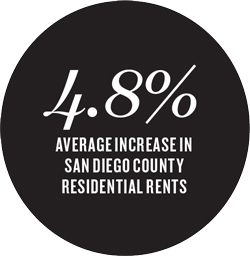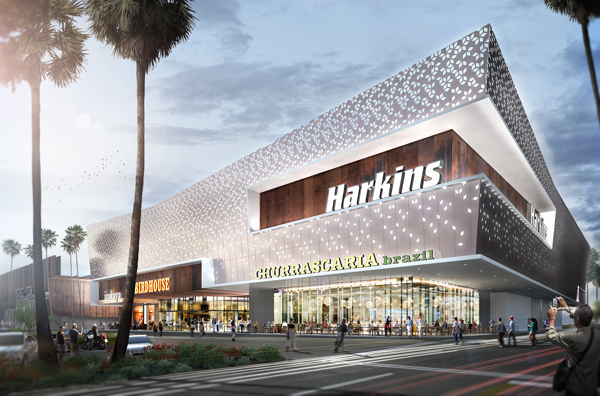Orange County
It’s always sunny in Orange County, which continues to lure Angelenos who are being priced out of their native market. The result is a consistent uptick in residential values throughout the region.
“There’s a tremendous amount of influx into the O.C. from L.A.,” said Greg Moers, an agent with TripleMint. “And the county is so huge, with so many different cities, that there are lots of options.”
Overall, pricing during the first quarter of 2017 rose in 66 of 83 O.C. zip codes (compared to 50 in the same period last year), the Orange County Register reported. In the area’s priciest zip codes, where median home prices start at $742,000, 2,630 homes have sold, marking a 7.2 percent increase in volume since the same time last year.
The demand is seriously draining supply, said Rob Giem, a Realtor with Compass. “Agents are running around looking for properties,” he said. “We’ve reached one of the most critical inventory shortages we’ve had. Aside from a handful of small developments in their later stages, there’s not many places to build.”
Michael Shapiro, chairman and CEO of HOM Sotheby’s International Realty in Orange County, said that certain areas that have long been considered less desirable — such as parts of Santa Ana and the west side of Costa Mesa — are undergoing gentrification and developing amenities “more attuned to the larger cities,” which he said will lead to rising values in the next few years.
The O.C. has also seen growth in the retail and hospitality sectors. Significant projects underway include the redevelopment of the Laguna Hills Mall as Five Lagunas; the construction is being done by C.W. Driver. The project, scheduled for completion next year, will encompass a movie theater, a park and retail space. The developer will also prep an 8-acre parcel nearby, which is slated for a 350-unit residential complex to be built by Merlone Geier Partners. C.W. Driver is also working on the $225 million redevelopment of the 600-plus room Anabella Hotel in Anaheim, according to the Register.
San Diego County
A slowdown in construction across San Diego County has helped propel demand for rentals, says Nat Kunes, VP of product management at AppFolio, a cloud-based property-management software company that works with commercial and investment property owners nationwide. AppFolio reported that rents throughout San Diego have gone up 4.8 percent this year, compared with a national average of 2.1 percent.
 “We will start to see some limits. The market can’t sustainably grow at these rates over longer periods of time,” said Kunes.
“We will start to see some limits. The market can’t sustainably grow at these rates over longer periods of time,” said Kunes.
In the commercial sector, San Diego rents are relatively stagnant. That’s partly due to the amount of new office space soon coming online, said Gary Bechtel, president of Ladera Ranch-based Money360, a commercial real estate lender. According to JLL’s Q2 2017 report, some 563,859 square feet of office space was under construction. Rents averaged $2.68 per square foot, up from $2.63 in Q1 and $2.62 in Q4 2016, and the office vacancy rate was at 12.4 percent, the report said.
One of the area’s biggest projects is the mixed-use Makers Quarter in San Diego’s Upper East Village. When completed in 2020, the complex will feature about 276,000 square feet of collaborative office space in addition to 145,000 square feet of retail and 800 residential units.
On a positive note, some new office spaces have eager tenants ready to move in. BioMed Realty, which specializes in life-science real estate, has completed work on the $146 million, 316,000-square-foot i3 campus at University Town Center, slated for occupancy this summer by biotech giant Illumina. And in April 2017, BioMed Realty ground broke on the Center for Novel Therapeutics, in partnership with UC San Diego; the 110,000-square-foot research facility will house private-sector companies in the medical research and development field.
Ventura County
Those priced out of L.A. County who don’t head south to Orange County often head north to Ventura.
But lower pricing is just one of the draws, as the county is known for its agricultural base and scenic coastline. Upcoming multifamily developments include the The Farm, from Williams Homes, to be constructed on 35.7 acres of farmland and foothills for a total of 131 units. Ventura Harbor is also in the middle of a $93 million redevelopment project comprising waterfront apartments, office space, a park and a marina. The 26-acre project is expected to be completed in 2019 and is under development by Sondermann Ring Partners.
Also in Ventura, on Seaward Avenue, a new 128-room, 88,000-square-foot Marriott Residence is underway, according to the Ventura County Reporter. Approvals are in place for Kaiser Permanente’s new 7.6-acre campus in what is commonly called the Ventura Wellness District due to the nearby Ventura County Medical Center. And Mar-Y-Cel is the name of the Richman Group’s mixed-use project under development in downtown Ventura, which involves the demolition of a 1940s industrial building. The project will feature 138 rental units and more than 6,000 square feet of commercial space.
Inland Empire
Some 2.7 million square feet of industrial construction across the Inland Empire indicates that the region is “still going strong,” said Bechtel. The area, encompassing Riverside, Moreno Valley and San Bernardino, is known as the state’s hub for warehousing and distribution.
“There’s a lot of building and a lot of absorption,” said Bechtel, adding that new businesses and the expansion of existing ones across numerous categories — from furniture to fashion — are going to need the services of these fulfillment centers.
On the retail front, shop spaces are still being added to the 18-month-old Mountain Grove mall in Redlands, which, at full buildout, is expected to cover some 450,000 square feet of shopping, dining and entertainment offerings. In Montclair, at the western edge of San Bernardino County, an end-of-2017 completion is expected for renovations on the Montclair Place mall.
The Inland Empire has a solid job market, according to California’s Employment Development Department. Unemployment in Riverside-San Bernardino-Ontario was 4.5 percent in May, down from an estimate of 5.4 percent last year. As a result, demand for single-family homes in the Inland Empire has fueled the strongest building activity in nearly a decade, according to a new report from UC Riverside.
New multifamily builds due to hit the market soon include Autumn Villas, a 68-unit development of single-family detached homes near CSU San Bernardino, Richmond American’s Fallbrook development in Riverside and the Park Place community in southern Ontario.




